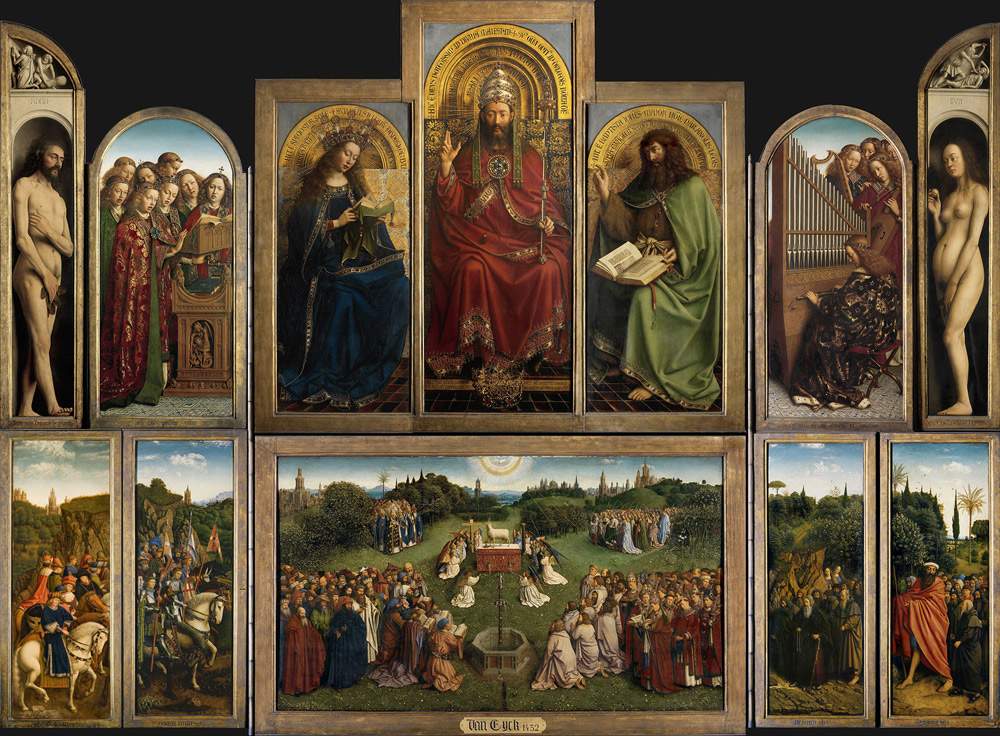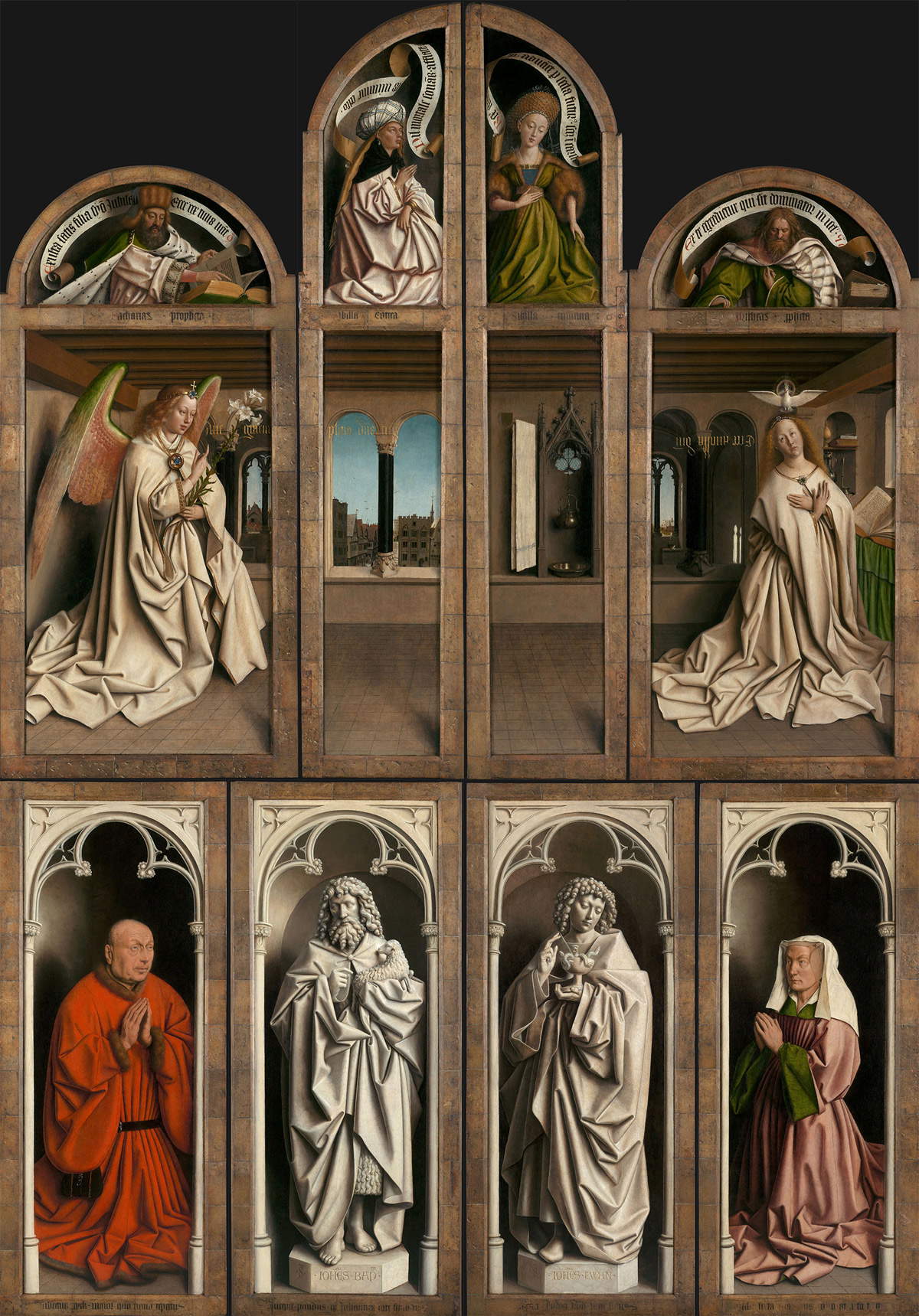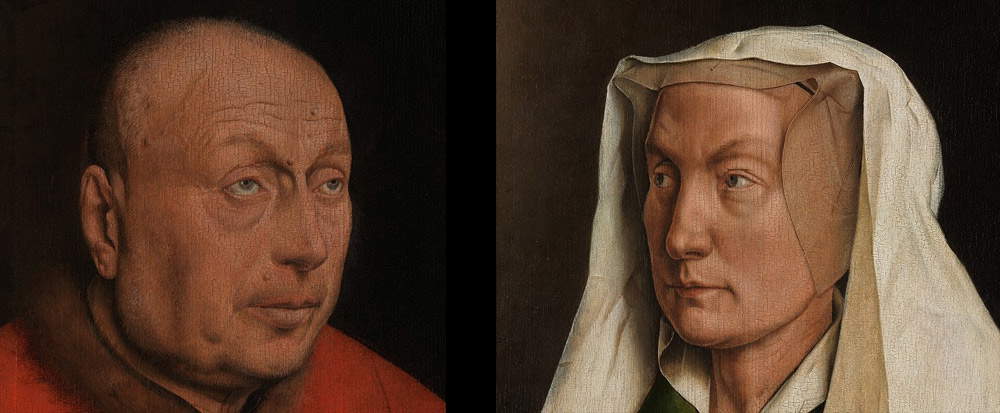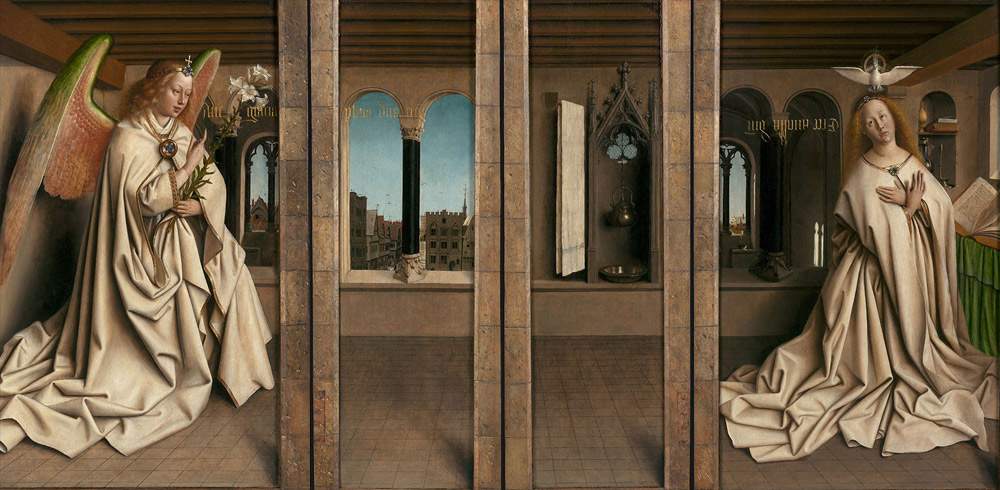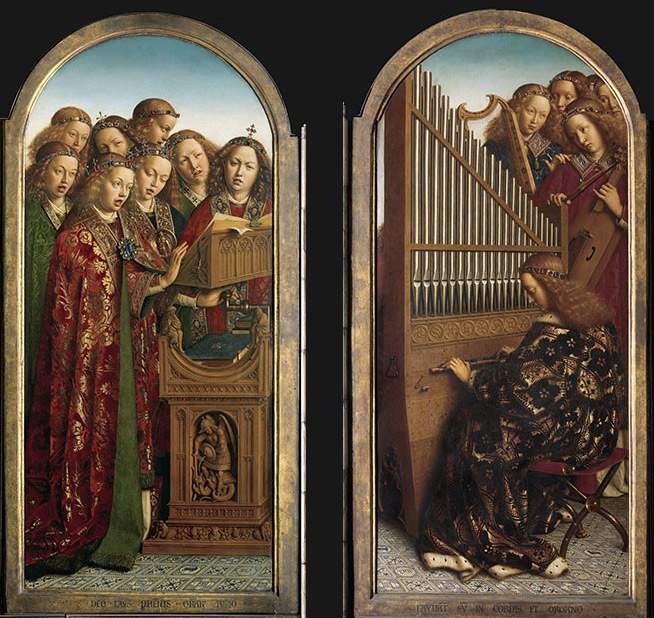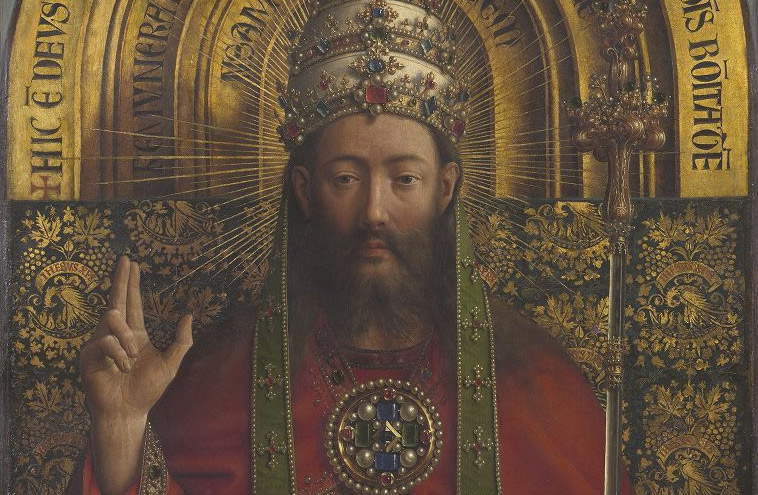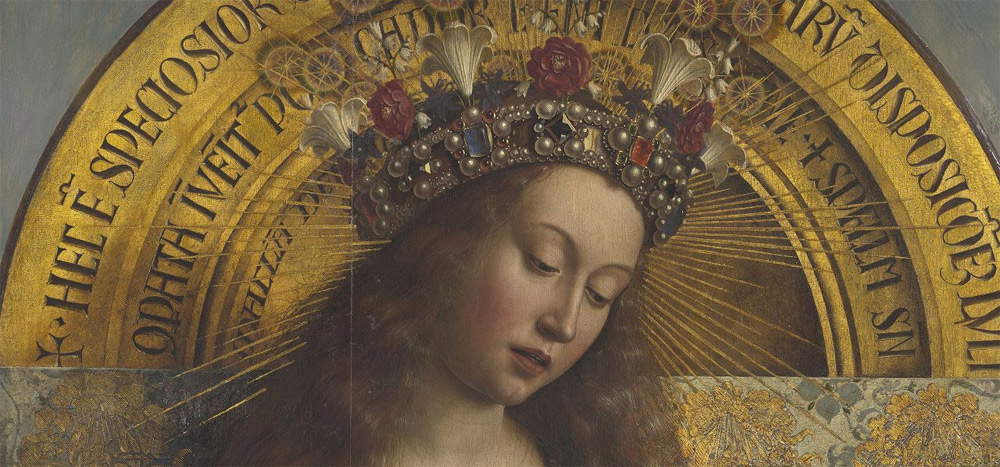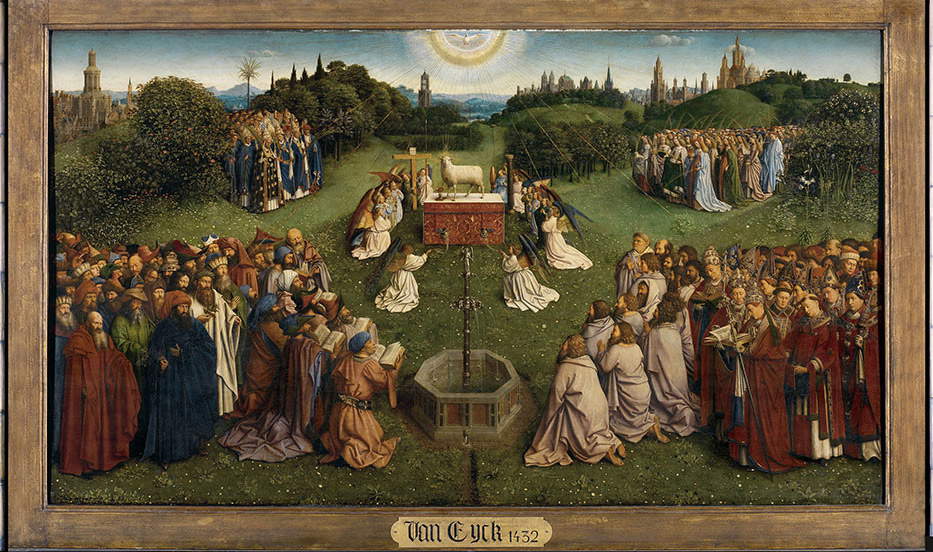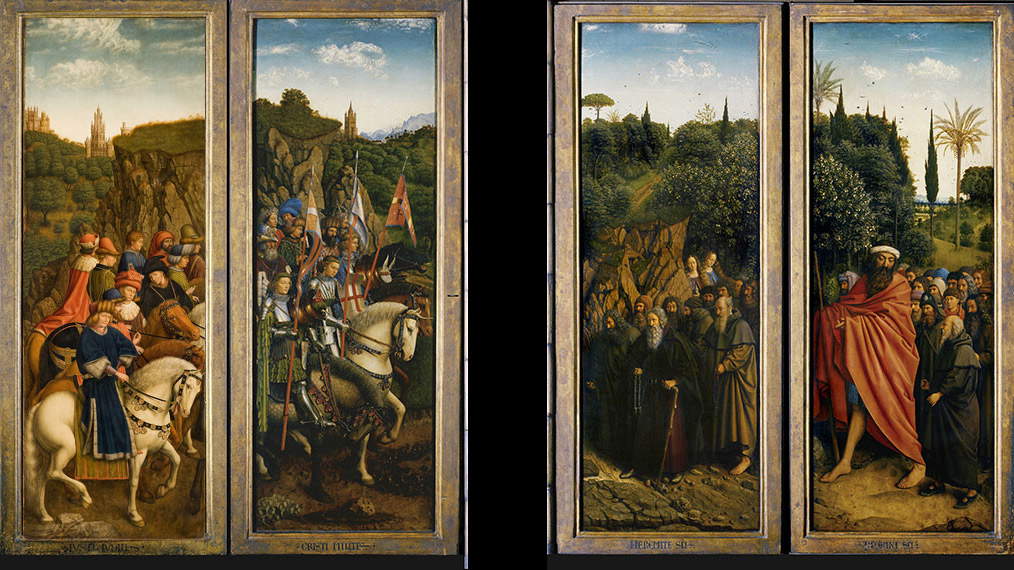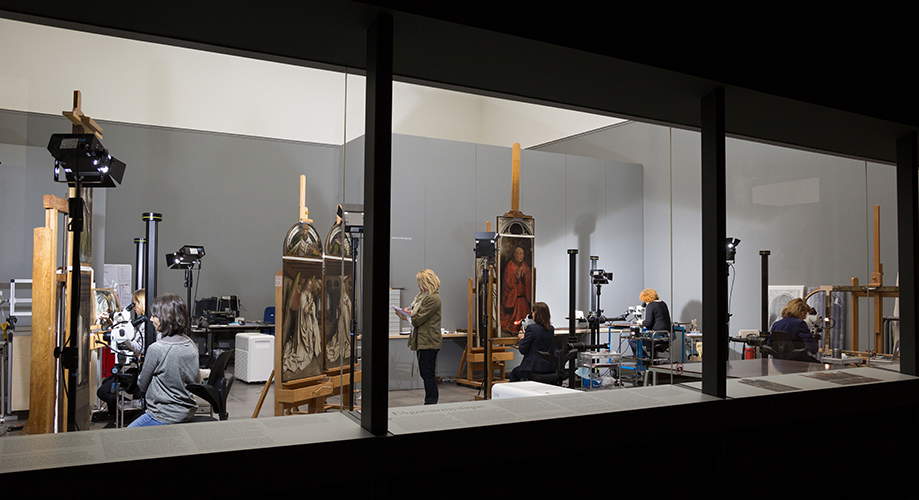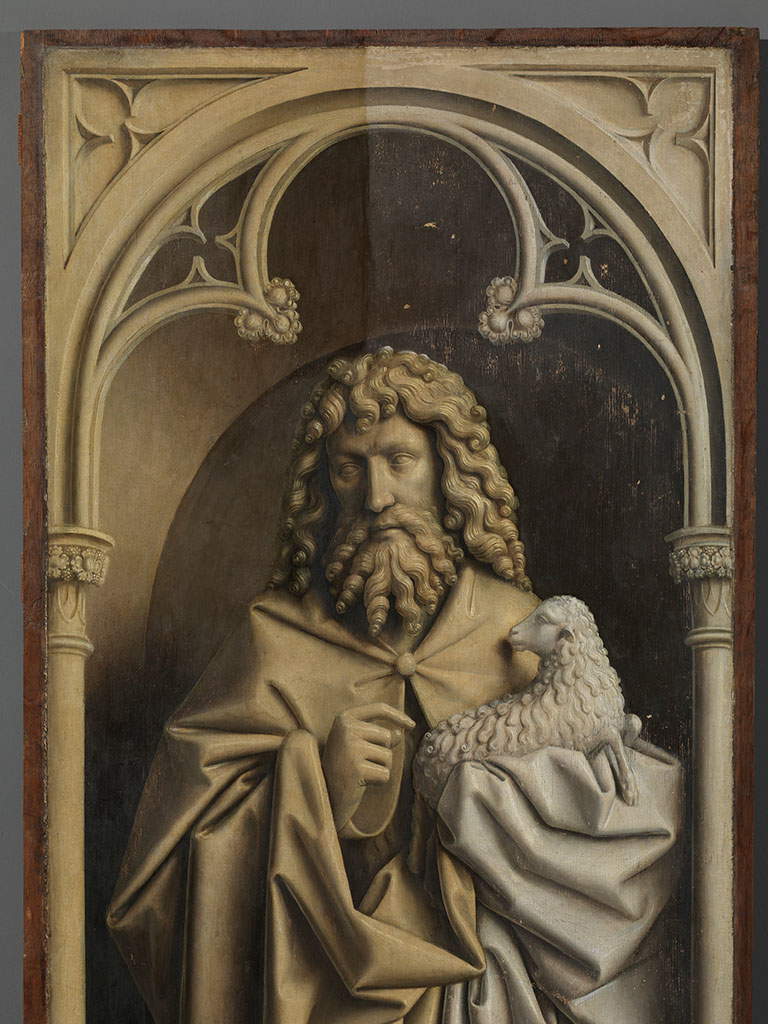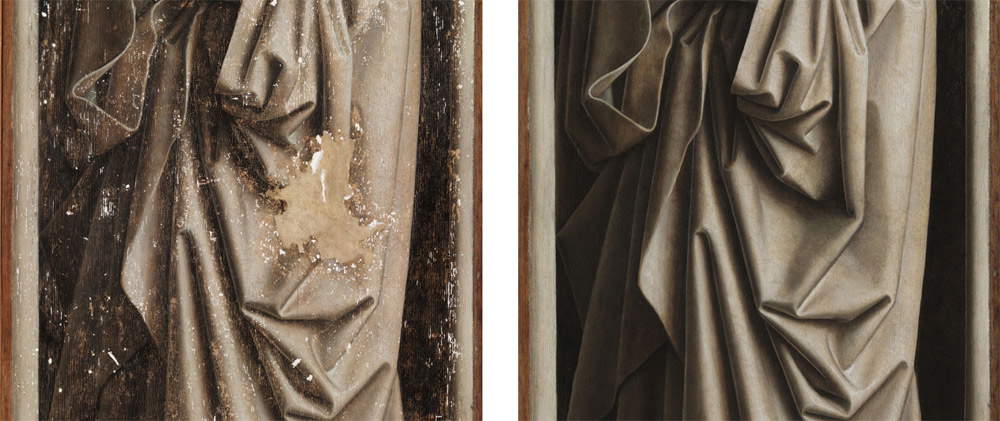by Federico Giannini, Ilaria Baratta , published on 26/05/2018
Categories: Works and artists
- Quaderni di viaggio / Disclaimer
The Polyptych of the Mystical Lamb, by Jan van Eyck and Hubert van Eyck, was made in 1432 and is one of the great masterpieces of world art history. It is located in Ghent, in the Cathedral of St. Bavon.
It was 1823 when, in Berlin, a restorer working on the Polyptych of the Mystic Lamb, one of the greatest masterpieces in the history of world art, removed some of the repainting and discovered an illuminating inscription, which read, “Pictor Hubertus eeyck. maior quo nemo repertus / Incepit. pondus. que Johannes arte secundus / [Frater] perfecit. Judoci Vijd prece fretus / VersU seXta MaI. Vos CoLLocat aCta tUerI [1432]” (“The painter Hubert van Eyck, the greatest ever, began this burdensome work, which his brother Jan, second in art, brought to completion, on the commission of Joos Vijd. With this verse, on May 6, 1432, place what was done under your protection.”). The quatrain had shed light on the names of the two authors of the spectacular work preserved in St. Bavon’s Cathedral in Ghent, in the heart of Flanders: Jan van Eyck (Maaseik, c. 1390 - Bruges, 1441) and his older brother, Hubert van Eyck (? - Ghent, 1426). And it is precisely from here that it is possible to begin an exciting journey inside one of the best known, yet at the same time most enigmatic, works in the entire history of art. We do not know how the two brothers divided the tasks, and the task is also made difficult by the fact that we know of no certain works by Hubert van Eyck, so we do not know how he painted. Moreover, some aspects of the overall meaning, on which, moreover, there is no unanimous agreement, remain to be clarified. And again, given the travails the work has undergone over the centuries, we cannot establish with certainty where it was originally located. It is therefore necessary to go step by step.
The Polyptych of the Mystic Lamb is a monumental work, and it is the most impressive of the polyptychs made in Flanders during the 15th century: it measures three and a half meters in height, and four and a half meters in width when open. In fact, the polyptych is painted on both sides and was designed to be closed or open (and thus to show certain compartments rather than others) according to occasion. When the polyptych is open, it shows the viewer twelve panels, divided into two registers. However, it is necessary to point out that the layout, as we see it today, according to some scholars may not correspond to the original idea of Hubert and Jan van Eyck: an art historian such as Emile Renders, who moreover considered Jan van Eyck to be the sole author of the painting and the inscription to be a later and inauthentic addition, went so far as to speculate that the polyptych was the result of the assemblage of several works by the younger of the two brothers. According to this theory, the commissioner Joos Vijd would have bought separate works and assembled them rather randomly into a single polyptych. It must then be questioned whether the configuration of the complex that we get to see today corresponds to the one actually imagined by Hubert and Jan van Eyck (or his patron), because over the centuries the Polyptych of the Mystical Lamb has been disassembled and assembled several times: however, the current reconstruction seems to be the most likely one.
 |
| Jan van Eyck and Hubert van Eyck, Polyptych of the Mystical Lamb (dated 1432; oil on panel, 350 x 470 cm open, 350 x 223 cm closed; Ghent, Cathedral of St. Bavon). Ph. Credit KIK-IRPA |
 |
| The Polyptych of the Mystical Lamb closed. Ph. Credit KIK-IRPA |
The panels we see when the polyptych is closed offer us a kind of “introduction” to the themes that the work subtends. It is a rather austere whole, a “measured prelude to the polychromatic splendor of the interior” (as Otto Pächt called it). The lower register is occupied by four panels: on the sides we find the life-size portraits of the two donors, namely the aforementioned Joos Vijd, a nobleman of the Gent patriciate, wealthy landowner, and from 1395 ever-present on the Gent city council, and his wife Lysbette Borluut. The intent of the couple was not only to include, in their chapel within what was then the church of St. John (the building would be dedicated to St. Bavon and elevated to the rank of Cathedral only in the sixteenth century), a work that could preserve their memory, but also to demonstrate to the entire city of Ghent the social prestige they had acquired: such an impressive work, created by the two best artists on the square, constituted an effective demonstration of power in those times. These are also two of the earliest (as well as most interesting) examples of Flemish Renaissance portraiture, distinguished by their high degree of realism and attention to detail. The impressive analytical skills of Jan van Eyck, to whom the two portraits are attributed, are all aimed at rendering a faithful image of Joos Vijd and Lysbette Borluut: the painter does not omit moles, shading of the hair (even the patron appears to us with a day-old beard), wrinkles, and dark circles. The recent discovery of oil painting had enabled artists to be able to take the naturalism of their achievements to the highest level, and patrons liked to experiment with how far their artists could go.
Immediately after the portraits of the donors we encounter the figures of two saints-John the Baptist and John the Evangelist, the patron saints of the church, to whom the prayers of the patron and his wife are addressed, and with whom the latter share a single common space, despite the fact that each figure occupies a single compartment. They are painted in grisaille, or monochrome in shades of gray, so that they take on the appearance of two statues: this spectacular trompe-l-oeil illusionistic effect not only enhances the naturalism of the portraits of Joos Vijd and Lysbette Borluut, as several scholars have noted and as is moreover evident from direct comparison, but also demonstrates the degree of innovation to which Jan van Eyck’s painting had reached. The painter had not been the first to use the grisaille technique to create statue-like figures: his fellow countryman Robert Campin (Valenciennes, c. 1378 - Tournai, 1444) had already done so, but van Eyck, with his harsher mark, sharper contrasts of light, and greater attention to certain details (note the curls in the hair of the two saints, or the fleece of the lamb of the Baptist: the artist even wanted to imitate the sculptor’s drill marks), had achieved far more striking effects of illusionism.
In contrast, the upper register houses a refined Annunciation, to which the figures occupying the lunettes also allude. These are two prophets at either end (Zechariah on the left and Micah on the right), and two sibyls in the center (the Erythraean Sibyl on the left, the Cumaean Sibyl on the right): each carries a cartouche. Zechariah is accompanied by an inscription from his book, which reads “Exault satis filia Syon jubila [...] ecce rex tuus venit” (“Rejoice greatly, daughter of Zion, rejoice [...], behold, to you your king comes”). Micah also carries a passage from his book, “De te egreditur qui sit dominator in Israel” (“From you shall come forth the one who will be ruler in Israel”). In contrast, the Erythraean Sibyl is associated with a phrase that takes a line from Virgil ’sAeneid and says “nil mortale sonans afflata es numine celso” (“Singing nothing mortal you are inspired by a high spirit”): in the Aeneid, the words refer to the Sibyl, but in the context of the Gent painting they can be read as a reference to the Annunciation. The same is true for the cartouche of the Cumaean Sibyl, where the phrase “Rex altissimus adveniet per secula futurus scilicet in carne” (“The most high king will come and become flesh for all ages”) obviously refers to the coming of Christ: the Latin quotation is taken from St. Augustine ’s De civitate Dei, which, in turn, translates from Greek a phrase from the Sibylline Oracles, twelve books of various prophecies originally composed between the second and first centuries before Christ and then reworked in the early centuries of Christianity.
The prophets and sibyls foretold the birth of Jesus: the narrative then leads to the scene of theAnnunciation, with the two protagonists clad in white robes and occupying a unified space, separated, however, by two central panels depicting details of the room within which the scene takes place. Even in these two panels, Jan van Eyck’s meticulousness left out no detail: in the first, in addition to the two elegant mullioned windows with black marble columns and Corinthian capitals, we can in fact appreciate a view of Ghent (although it is difficult to say whether it corresponds to an actual area of the city), complete with a flight of birds in the sky, while the second is a detailed depiction of the interior of Mary’s dwelling where we see, leaning against the wall, a very fine Gothic niche, surmounted by a cusp with a trefoil arch, containing a bronze basin, a pitcher also made of bronze, and a linen towel, edged in blue. These objects allude to the Virgin’s purity, but they also have the merit of introducing us to a typical interior of a Flemish house of the early 15th century. Thearchangel Gabriel, as per typical iconography, arrives bearing a lily, also a symbol of the Virgin’s purity, and uttering the phrase “Ave gratia plena D[omi]n[u]s tecum[m]” (“Hail, O full of grace, the Lord is with thee”). She, kneeling and joining her hands on her chest, responds “Ecce ancilla Domini” (“Behold the handmaid of the Lord”), as the dove of the Holy Spirit flies over her head. Interestingly, theAnnunciation scene could help resolve one of the most debated questions around Jan van Eyck’s art: whether he traveled to Italy, and more specifically to Florence. Art historian Penny Jolly, in a 1998 scholarly essay, stated that theAnnunciation “clearly demonstrates evidence of contact with the Florentine figurative repertoire because of the inclusion of three unusual features: the two panels sandwiched between the Virgin and the angel, the upside-down written response of the Madonna to God, and the shape of the rays of light seen on the wall behind the Virgin.” According to Penny Jolly, the two panels recall the space that Lorenzo Monaco (Siena?, c. 1370 - Florence, 1425) inserted between Gabriel and Mary in theAnnunciation for the Salimbeni altarpiece in Santa Trinita in Florence; moreover, the upside-down inscription “Ecce ancilla Domini” appears, for example, in the anonymous Annunciation of the Santissima Annunziata; and again, the light taking the shape of the windows on the wall recalls a similar reflection found in Beato Angelico ’sAnnunciation (Vicchio, c. 1395 - Rome, 1455). A sum of elements that could therefore suggest a knowledge of coeval Italian art on the part of Jan van Eyck, to whom the scene is to be attributed.
 |
| Donors Joos Vijd and Lysbette Borluut. Ph. Credit KIK-IRPA |
 |
| Details of the faces of the donors. Ph. Credit KIK-IRPA |
 |
| The panels with St. John the Baptist and St. John the Evangelist. Ph. Credit KIK-IRPA |
 |
| Detail of the Saint John the Evangelist. Ph. Credit KIK-IRPA |
 |
| Prophets and sibyls. Ph. Credit KIK-IRPA |
 |
| Annunciation. Ph. Credit KIK-IRPA |
 |
| View of Gent. ph. Credit KIK-IRPA |
The birth of Christ is thus announced, and the polyptych can be opened: we are faced with a much more heterogeneous and articulated ensemble than when the polyptych is closed, and at the same time much more complicated, with figures depicted at different scales, which is why several art historians have wanted to identify the hands of the two brothers in the work. Most are inclined to attribute the conception of the ensemble to Hubert and the execution of the figures to Jan (partly due to the fact that almost all of them are very close to his style), although the qualitative gap in the three central figures of the open polyptych may suggest that they should be attributed to Hubert’s hand. All agree, however, on assigning the figures at opposite ends to Jan: they are the progenitors, Adam and Eve. Both are nude, but while Adam covers his pubis with a fig leaf, Eve, who holds the fruit of sin with her right hand, is shown without any filter, since with her hand she holds the leaf just below the mount of Venus, totally uncovering herself to the view of the relative. These two panels constitute an extraordinary innovation: no artist before had ever gone so far as to depict the naked human body, and moreover in a work intended for a house of worship, with such crude naturalism. The artist wanted to render with extreme accuracy the softness of the epidermis, the lightness of the hair that, frayed and slightly disordered, falls over the shoulders (Eve’s straight, Adam’s curly), the down that covers Adam’s chest and his arms, or Eve’s pubis, and addirritura the pulsating veins. “Eve,” wrote art historian Kenneth Clark in one of his articles, “is proof of how minutely ’realistic’ in the rendering of details an artist can be, while at the same time subordinating everything to an ideal form.” Indeed, the dependence of the progenitors on classical models has also been noted: the pose of the demure Venus, for example, may have set a precedent.
The figures of Adam and Eve are immediately followed by two panels with musician angels: on the left, a group is engaged in singing by reading words from a lectern set on a bench decorated with a figuration of St. Michael defeating the dragon. On the right, an angel plays an organ while the others accompany him on stringed instruments. Here, van Eyck wanted to avoid stereotypical figurations, and lavished himself on yet another piece of singular realism: to realize this, one only has to observe the expressions of the angels, who are concentrated as they sing and play (we see half-closed eyes, frowning foreheads, gazes following the scores). Their songs glorify the central figure of the Deësis, the iconographic theme, of Byzantine origin, of Christ the King enthroned in the middle flanked by Our Lady and St. John the Baptist. These are the three figures that, appearing flatter and more traditional than those in the rest of the polyptych, one is inclined to assign to the hand of Hubert van Eyck. In the center, Christ the King is clothed in a broad red robe, wears a three-crowned tiara, with his right hand makes the gesture of blessing, and with his left shows the scepter: these are all attributes that identify him as Rex Regum, Dominum Dominantium (“King of kings, Lord of lords”), a title we see on the lower edge of his cloak, adorned with pearls. Christ’s kingship is, moreover, also underscored by the inscriptions running along the top of the throne, the rich jewels decorating his robe, and the additional crown laid at his feet. His figure has often been mistaken for that of God the Father or the Trinity, since attributes appear in the figuration that could lead to such a reading (the inscription “Deus potentissimus” or the gesture of the three fingers, for example), but the iconographic tradition of having the figure of Jesus at the center of the Deësis, and additional attributes (the pelican, symbol of Christ, or the vine motif alluding to the sacrament of the Eucharist and the sacrifice of the cross) leave little doubt as to the identity of the central figure. The preciosity that distinguishes the three figures of the Deësis is unparalleled in the rest of the polyptych. Every detail exudes opulence: John the Baptist himself, usually dressed in threadbare garments, wears a cape edged in gold and adorned with pearls and gems over his traditional tunic made of camel hair. Also particularly elaborate is the Virgin’s crown, which alternates lilies and roses, her flowers, with precious stones. These are elements that highlight the taste for luxury of the patrons of the polyptych.
The lower register, on the other hand, features the panel with theadoration of the mystical lamb. The lamb, with its head surrounded by a nimbus, is standing above an altar bearing the inscription “Ecce agnus Dei qui tollit peccata mundi” (“Behold the lamb of God who takes away the sins of the world”): blood is gushing from its breast, also an allusion to the blood shed by Jesus on the cross (in fact, we glimpse it behind the animal, carried by some angels bearing the symbols of the Passion). The blood falls inside a chalice, again symbolizing the sacrament of the Eucharist. The scene is immersed in a verdant landscape, a symbol of Paradise, and in the background we also see the outline of a city, with towers, palaces, bell towers (it is an allegory of the heavenly Jerusalem, the perfect city that appears to St. John in a vision): the whole landscape is invested by the light emanating from the dove of the Holy Spirit. A light that produces no shadow: indeed, inRevelation we read that “the city has no need of the light of the sun, nor of the light of the moon: the glory of God illuminates it, and its lamp is the lamb.” Around the lamb is arranged a crowd of people who have come to worship him: there are the apostles, saints and holy men, popes, ancient writers and philosophers, and prophets. It is another Johannine image: in Revelation we read that “there appeared an immense multitude, which no one could count, from every nation, race, people and language. They all stood before the throne and before the Lamb, wrapped in white robes, and they carried palms in their hands. And they cried with a loud voice, ’Salvation belongs to our God seated on the throne and to the Lamb.’” In the lineup of saints, in the upper right, we recognize in the front row, by their attributes, St. Agnes (with the lamb), St. Barbara (with the tower) and St. Dorothea (with a basket of flowers), and among the figures in the lower left we also wanted to recognize, in the bearded man with the white tunic and the head girded with laurel, the poet Virgil. In the exact center we can admire the fountain of life: on the edge of the basin runs the inscription “hic est fons aque vite procedens de sede Dei + agni” (“This is the fountain of the water of life, which proceeds from the throne of God and the lamb”). The fountain plays a strong symbolic role, since the water flows toward the lower edge, thus toward the altar of the Vijd chapel, where the priest officiated at Mass: it is a kind of call to the faithful, since, again inRevelation, God tells St. John that he will give drink at the fountain of the water of life, and van Eyck wanted to give substance to this image by having the water flow outside the polyptych, as if it were to flood the church.
In the remaining four side panels we notice other groups of people walking toward the lamb: these are the people coming to worship him. In the far right panel we have the pilgrims, led by St. Christopher (his name, in Greek, literally means “the one who brings Christ”). This is followed by the panel with the martyrs, while on the left we find, next to the central panel, the “Cristi milites,” or Christ’s soldiers, while at the far end is the panel with the righteous judges. The latter is the only non-original panel in the complex: the panel painted by van Eyck was in fact stolen in 1934, and the one we see now is a copy made after the war by restorer Jef van der Veken (Antwerp, 1872 - Ixelles, 1964).
 |
| Adam and Eve, and details of their bodies. Ph. Credit KIK-IRPA |
 |
| Detail of Eve’s body. Ph. Credit KIK-IRPA |
 |
| The panels with the angels. Ph. Credit KIK-IRPA |
 |
| The faces of the angels. Ph. Credit KIK-IRPA |
 |
| The Deësis. Ph. Credit KIK-IRPA |
 |
| Christ the King. Ph. Credit KIK-IRPA |
 |
| Our Lady. Ph. Credit KIK-IRPA |
 |
| The panel with the mystic lamb. Ph. Credit KIK-IRPA |
 |
| Detail of the mystic lamb. Ph. Credit KIK-IRPA |
 |
| The saints. Ph. Credit KIK-IRPA |
 |
| Writers and poets worship the mystic lamb. Ph. Credit KIK-IRPA |
 |
| The panels of the lower register. Ph. Credit KIK-IRPA |
What, then, is the overall meaning of such an articulated whole? The entire iconographic program, which was written by resorting to various sources, centers on the theme of redemption. Adam and Eve, whose figures are surmounted by lunettes decorated with, respectively, the sacrifice of Cain and Abel and the killing of Abel, are seen as those who forced humanity to a life in sin. Adam is in fact accompanied by the inscription “Adam nos in morte precipitat” (“Adam plunged us into death”), and at Eve’s feet we read “Eva occidendo orfuit” (“Eve harmed us with a crime”). However, humanity, despite being forced to live in sin, can still be saved thanks to Christ, who sacrificed himself to redeem all sinners: the lamb, in the Christian tradition, is the symbol of Jesus’ sacrifice, prophesied both in the Old Testament books and in the Gospel of John (when the evangelist meets Jesus, in the first chapter of the book, he addresses him with the famous phrase “behold the lamb of God, who takes away the sins of the world”). The humanity that has accepted faith and has thus been redeemed from sin (i.e., the humanity that, in the painting, gathers around the lamb or is about to come to reverence him) is the same humanity that God has saved and that will be able to access Paradise governed by the characters of the Deësis. This is the most obvious meaning of the painting, but a work as complex as the Polyptych of the Mystical Lamb introduces other themes as well. It has been suggested, for example, that the polyptych also played an important civic role: St. John the Baptist was at the time the patron saint of Ghent (and the lamb, as is well known, is one of his attributes), and it is safe to imagine that the commissioners also intended to give the city a work in which the inhabitants could recognize themselves. Still, it has been speculated that the polyptych can also be read as a grand allegory of the sacrament of the Eucharist: art historian Dana Ruth Goodgal has conducted in-depth studies of the iconography of the polyptych and discovered how each individual figuration corresponds to certain passages of the Tractatus de corpore Christi written in the 1400s by the religious Olivier de Langhe, coming to the conclusion that the theme of the polyptych is rather “the union of the mystical body of Christ in the Eucharistic sacrament.” But there are many levels of interpretation, not least because the observer can approach the polyptych from different perspectives. Erwin Panofsky has written that “van Eyck’s eye operates like a microscope and a telescope at the same time, so that the observer is forced to oscillate between a position reasonably distant from the painting and several positions very close to it”: in other words, van Eyck has offered us a work that is amenable to multiple readings and points of view.
And it is not only the meaning of the painting that is complicated: so is its centuries-old history, the latest chapter of which is represented by the major restoration to which the Polyptych of the Mystical Lamb has been subjected since 2012, and which will see its conclusion in 2020, when the panels of the open polyptych will also be arranged and the work will be returned to the city of Ghent. In the meantime, the public can see the painting while it is being worked on at the Museum of Fine Arts in Ghent. Over the centuries, the work has in fact undergone several repaintings and reworkings that have altered its coloring, making the surfaces darker, flattening the contrasts and balancing the colors. Not to mention the fact that the polyptych’s state of preservation had deteriorated: thus, from a preliminary investigation conducted in 2010, it was concluded that the work needed restoration, which began two years later, thanks in part to financial support from The Getty Foundation. Without intervention, the damage could have become irreversible.
After an initial cleaning phase, the team of restorers, led by Bart Devolder of KIK-IRPA (the Royal Institute for the Protection of Cultural Heritage, Belgium’s highest authority on artwork restoration), began removing the patinas that had accumulated on the surface, discovering that large sections of the polyptych (about 70 percent of the total) had undergone heavy repainting between the sixteenth and seventeenth centuries, causing, said Bart Devolder, “for more than four hundred years we have not actually seen the real Gent altarpiece.” After heated discussions, the team, supported by a scientific committee of the highest caliber in which many of the best specialists in Flemish Renaissance painting participate, decided to remove the repainting, since the operation could be conducted with maximum safety. The next step was loss compensation: a measure taken to restore visual integrity to the panels of the Polyptych of the Mystic Lamb and which, Bart Devolder said, “was conducted according to modern ethical principles of conservation, making sure that the retouches did not cover the original materials and that they were reversible and easy to remove for future interventions.” All the work has been documented on a dedicated website, which also allows for viewing high-resolution images of the polyptych before and after restoration.
 |
| KIK-IRPA technicians at work, in the Museum of Fine Arts, Ghent, on the polyptych’s compartments. Ph. Credit KIK-IRPA |
 |
| The closed polyptych, before and after restoration. Ph. Credit KIK-IRPA |
 |
| The Saint John the Baptist during the restoration. Ph. Credit KIK-IRPA |
 |
| The figure of St. John the Evangelist before and after reparations. Ph. Credit KIK-IRPA |
And the repainting that has altered the polyptych represents but one of the many vicissitudes the work has undergone over the centuries. Part of the original frame was lost when, in 1794, the French armies that had occupied Belgium sacked the Cathedral of St. Bavon, dismembering the polyptych and taking the central panels to Paris, from which they would return to Ghent only in 1816. Even earlier, the work, in 1566, had been dismantled and hidden in the Cathedral bell tower to save it from the fury of the Beeldenstorm, the iconoclastic wave of Protestants that swept over Belgium and Holland in the summer of 1566. Later, in 1781, the panels with Adam and Eve had themselves been dismantled and hidden because they were deemed obscene. After the return of the polyptych from Paris, the vicissitudes of the polyptych were not yet over: the authorities then at the helm of the Cathedral decided to sell six of the eight side compartments (that is, all but those of the progenitors) to an English collector, Edward Solly. In 1821, King Frederick William III of Prussia bought the compartments from Solly and allocated them to his collection preserved in Berlin (incidentally, in 1894 the king’s panels were sawn in half so that the front and back could be displayed separately). Meanwhile, the panels with Adam and Eve, still hidden, were sold to the Belgian state in 1861, but the polyptych could finally be reunited in 1920 when, after World War I, Germany was ordered to return the side compartments to Belgium. In 1934 there was the theft of the two panels with the Just Judges and the John the Baptist: the latter was found, the former is still missing. During World War II, the work was admitted to France, but was scouted by the Germans during the occupation of the country, and moved to Neuschwanstein Castle. It was later moved and the Americans, in 1945, found it at the site of the Alt Aussee mines, and immediately sent it back to Ghent, where it remained on display for only five years before undergoing restoration, which returned the work to the Cathedral only in 1986. The rest, is recent history.
Reference bibliography
- Lynn F. Jacobs, Opening Doors. The early Netherlandish triptych reinterpreted, Penn State University Press, 2011
- Till-Holger Borchert, Van Eyck to Dürer. The Influence of early Netherlandish painting on European Art, 14301530, Thames & Hudson, 2011
- Amanda Simpson, Van Eyck: the complete, Chaucer Press, 2006
- Bernhard Ridderbos, Henk Th. van Veen, Anne van Buren (eds.), Early Netherlandish paintings. Rediscovery, reception and research, J. Paul Getty Museum, 2005
- Alessandro Parronchi, Reconstructions. Piero della Francesca - the altar of Ghent, Medusa Edizioni, 2003
- Carlenrica Spantigati, Van Eyck, Giunti, 2000
- Penny Jolly, Jan van Eyck’s Italian Pilgrimage: A miraculous Florentine Annunciation and the Ghent Altarpiece in Zeitschrift für Kunstgeschichte, 61 (1998), pp. 369-394
- Craig Harbison, Jan Van Eyck. The Play of Realism, Reaktion Books, 1991
- Guy Bauman, Early Flemish Portraits: 14251525, The Metropolitan Museum, 1986
- Hugh Honour, John Fleming, A World History of Art, Laurence King Publishing, 1982
- Dana Ruth Goodgal, The iconography of the Ghent altarpiece, University of Pennsylvania, 1981
- Elisabeth Dhanens, Van Eyck: the Ghent altarpiece Dhanens, Viking, 1973
- Erwin Panofsky, The Friedsam Annunciation and the problem of the Ghent Altarpiece in Art Bulletin, 17 (1935), pp. 433-473
Warning: the translation into English of the original Italian article was created using automatic tools.
We undertake to review all articles, but we do not guarantee the total absence of inaccuracies in the translation due to the program. You can
find the original by clicking on the ITA button. If you find any mistake,please contact us.
